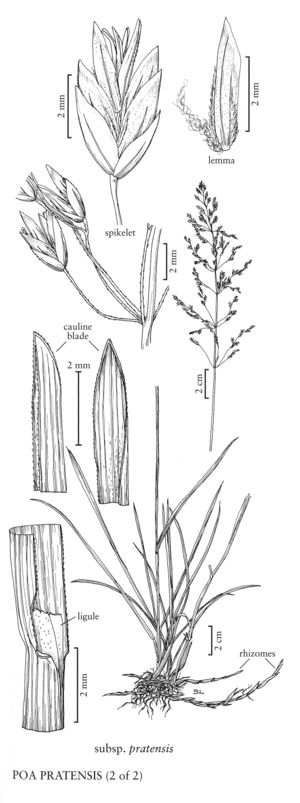Difference between revisions of "Poa pratensis subsp. pratensis"
FNA>Volume Importer |
FNA>Volume Importer |
(No difference)
| |
Revision as of 19:16, 24 September 2019
Plants densely to loosely tufted, often forming turf, culms clustered. Basal branching intra- and extravaginal. Culms 8-100 cm. Innovation shoot blades 10-45 cm long, 0.4-4 mm wide, some distinctly narrower than the cauline blades, all flat or some involute, usually soft, adaxial surfaces sparsely pubescent; cauline blades flat or folded. Panicles 5-18 cm, broadly pyramidal, open or somewhat contracted, with 3-5(7) branches per node; branches spreading to somewhat reflexed, smooth or sparsely to fairly densely scabrous, with several to many spikelets per branch. Spikelets lanceolate to broadly lanceolate, not bulbiferous; florets normal. Glume keels strongly compressed, sparsely to moderately scabrous; upper glumes shorter than or nearly equaling the lowest lemmas; lemmas 2.8-4.3 mm, finely muriculate, lateral veins glabrous; palea keels scabrous, glabrous, intercostal regions glabrous. 2n = 43, 44, 48,49, 50, 51, 52, 54,56, 58, 59, 62, 65, 66, 61, 74, ca. 85, ca. 86, 88, 89, 95.
Discussion
Poa pratensis subsp. pratensis grows throughout most cf the range of the species, but is absent from the high arctic, and only sporadic in the low arctic. It usually has a few narrow, flat or involute, intravaginal shoot leaves, in addition to some broader, extravaginal shoot leaves, and is intermediate between subspp. angustifolia and irrigata. For a comparison, see the descriptions of those subspecies.
Selected References
None.
